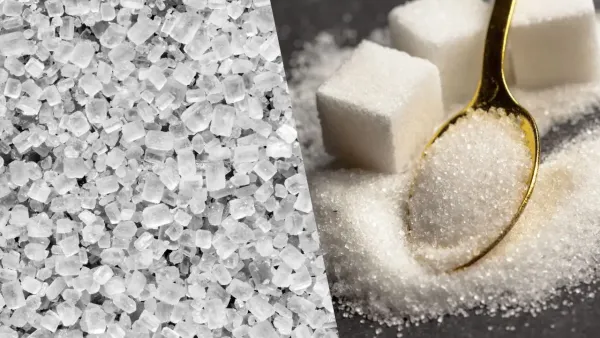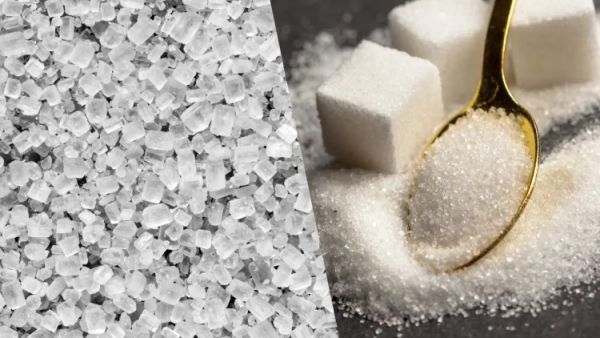
Although it is often called rock candy or candy sugar, mishri, sometimes called rock sugar, is a natural sweetener. However, it lacks the usual candy-like qualities, other from its sweetness.

On the other hand, sugar—also referred to as table sugar—is another sweetening agent. Although sugar and mishri are both made from sugarcane (though sugar may sometimes occasionally be made from sugar beets), their production methods are quite different. In contrast to sugar, which is refined, mishri is not.
There is a transitional phase in the process of turning sugarcane juice into sugar that results in raw sugar that looks a little unclean. A chunk is taken out of this stage in order to make mishri. The raw sugar is combined with milk and water and then put into large barrels that have threads attached. As the fluid progressively dries out, mishri crystallizes on the threads of these covered, cellar-stored barrels.
However, before sugar becomes the well-known table sugar, it must undergo further refining that involves the employment of several chemicals.
Which Is Better, Sugar or Mishri?
Because sugar and mishri are produced using different processes, they have different characteristics:
Since sugar is acidic, it takes longer to digest than mishri, which is said to be an alkaline meal.
While sugar is renowned for its heating properties, mishri has cooling properties.
According to Ayurvedic principles, mishri is said to balance the body’s pitta and vata doshas, which is a benefit that sugar isn’t linked to.
While sugar doesn’t have any therapeutic benefits, mishri has a number of them.
Unlike sugar, which lacks all of these nutrients, mishri preserves certain vitamins and minerals due to its little processing.
Mishri types
Usually, mishri comes in the following varieties:
On a thread, mishri solidified.
tiny, artificially created mishri crystals.
big, threadless masses of crystallization.
Ayurveda advises using mishri with a thread as it is the most traditional and genuine form.
Although sugar-based mishri is now widely available in today’s market, it lacks the distinctive thread. It is best to look for “dhage wali mishri” or mishri with a thread to make sure you are buying real mishri and not simply sugar. When purchasing mishri, this difference enables you to make a more educated decision.
In conclusion, your unique taste preferences and the particular needs of your culinary endeavors will determine whether you use sugar or Mishri (rock sugar) as your sweetener.
Sugar is a frequent ingredient in many recipes because of its neutral flavor and vast range of applications. However, Mishri is a great accompaniment to traditional Indian foods and drinks because of its unique caramel-like flavor and lower glycemic index.
When choosing, it’s essential to take into account elements like glycemic index, nutritional value, and flavor. Regardless of the sweetener you choose, moderation is essential to leading a healthy lifestyle. Both offer advantages and disadvantages.
Therefore, enjoy your sweets in moderation and relish the flavors they add to your dishes, whether you choose the classic sweetness of sugar or the distinctive character of Mishri.